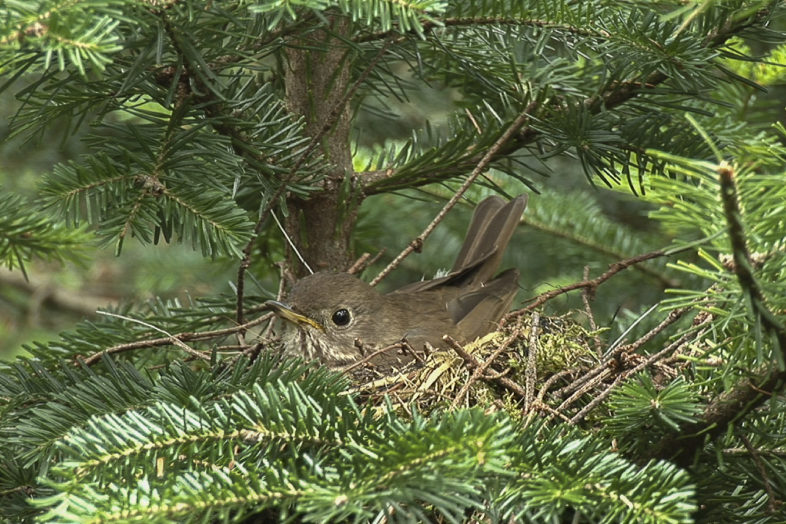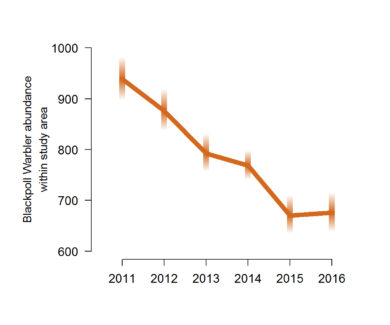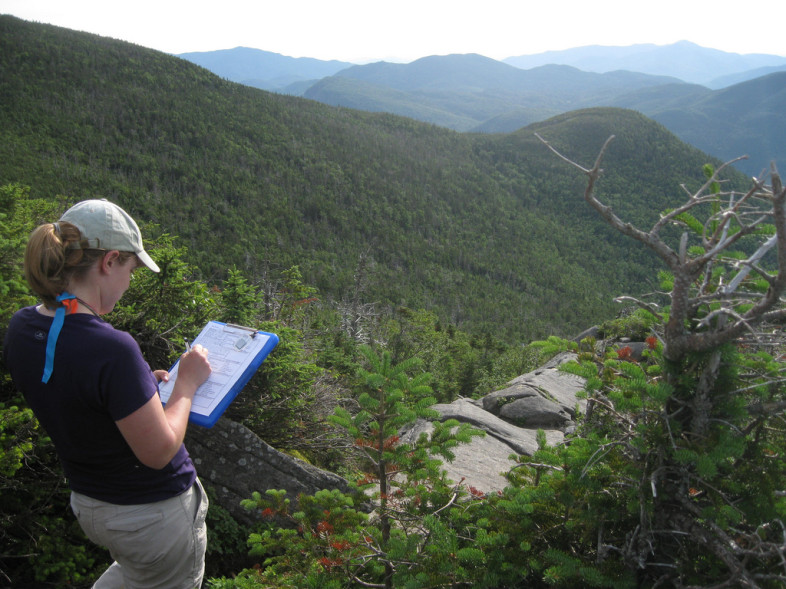NORWICH, VT – A 16-year study of mountain forest songbirds across New York and New England, including thrushes, warblers and other iconic species, has documented their population changes. Although species like Black-capped Chickadee and Swainson’s Thrush have thrived in the mountains during recent decades, some species that depend on the region’s evergreen forests of spruce and fir – notably Blackpoll Warbler – appear to have undergone substantial declines.
The State of Mountain Birds, a new report by the Vermont Center for Ecostudies (VCE), documents the health of bird populations using data from a unique citizen-science project called Mountain Birdwatch (MBW). Trained volunteers have been monitoring bird populations annually for VCE’s Mountain Birdwatch project since 2001. Scientists at VCE used these annual counts to create indicators of population change for each species, revealing which species are thriving and which may be in need of additional study and conservation. The full State of the Mountain Birds report is available online – www.mountainbirds.vtecostudies.org
“This report offers unique insights into population trends of species like Bicknell’s Thrush and Blackpoll Warbler and into the health of the mountain forests on which these birds depend,” said Dr. John Lloyd, VCE’s Director of Science. “As we demand more and more from our mountains – as sites to generate renewable energy, as a source for clean water, and as places for recreation – this kind of information will prove increasingly important.”

Bicknell’s Thrush (Catharus bicknelli) incubating a nest on Stratton, Vermont. Photo by K.P. McFarland
During the 16 years covered by this report, widespread species like Black-capped Chickadee and Swainson’s Thrush showed the most obvious gains. Neither species depends on mountain forests for habitat, but both now occur in more places and in greater numbers than they did when Mountain Birdwatch began. Although still quite uncommon in the Mountain Birdwatch study area, Fox Sparrow populations seem to be rising in western Maine and northern New Hampshire.
Songbirds showing the strongest signals of decline were those found only in the high country, notably Blackpoll Warbler. Populations of Bicknell’s Thrush, icon of the mountains, have been largely stable, with some evidence of modest declines in recent years.

Blackpoll Warbler numbers in the study area declined each year from 2011-2015, before apparently stabilizing at low numbers in 2016. Faded bars estimate the uncertainty in the estimate of abundance.
In some cases, population trends in the mountains of the northeastern U.S. seem to reflect broader trends. Global populations of Blackpoll Warbler, for example, have declined substantially in the past several decades, suggesting that regional declines documented by Mountain Birdwatch may be related to factors operating throughout the range of the species. Possible causes include loss of wintering or migration habitat, or systemic effects of global climate change. In other cases, population trends were distinct from broader trends. Swainson’s Thrush has declined in many parts of its range, but seems to be thriving in the mountains of the northeast. The reasons for their population growth remain unclear, although many climate-change models have predicted that species currently inhabiting low- and mid-elevation forests – like Swainson’s Thrush and Black-capped Chickadee – will increase in abundance at higher elevations as they track a changing climate.
“Keeping mountain ecosystems healthy and productive in the face of climate change and increased use by humans requires science-based solutions, and science-based solutions require the sort of data collected under Mountain Birdwatch,” noted Lloyd.
But the State of the Mountain Birds report isn’t just about the science and conservation. It is also a chance to celebrate the hundreds of citizen-scientists who each year venture out in the predawn darkness to count birds in the high country from the Adirondacks of New York to Maine’s Mount Katahdin, according to VCE’s Kent McFarland, who helped design the study. “It’s only through the hard work and dedication of these citizen-scientists that we can gain this peek into the lives of these amazing birds. Mountain Birdwatch is a great example of how birders can use their passion for the natural world to help inform conservation.”

